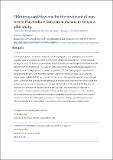Chlorproguanil/Dapsone for the Treatment of Non-severe Plasmodium Falciparum Malaria in Kenya: a pilot study
View/
Publication Date
5/1/1988Type
Article, Journalviews
downloads
Metadata
Show full item recordCitation
Watkins WM, Brandling-Bennett AD, Nevill CG, Carter JY, Boriga DA, Howells RE, Koech DK. Chlorproguanil/dapsone for the treatment of non-severe Plasmodium falciparum malaria in Kenya: a pilot study. Trans R Soc Trop Med Hyg. 1988;82(3):398-403. doi: 10.1016/0035-9203(88)90133-2. PMID: 3068855.
Abstract/
Chlorocycloguanil, the active metabolite of chlorproguanil, was synergistic in vitro with dapsone against 2 culture-adapted Plasmodium falciparum isolates from Kenya; maximal synergy occurred at lower concentrations that it did with pyrimethamine and sulfadoxine. 48 children with asymptomatic P. falciparum infections were treated with chlorproguanil (at a target dose of 1·2 mg/kg) and dapsone (target dose of 1·2 or 2·4 mg/kg); all were free of parasitaemia by day 7. The following numbers had recurrences on days 14, 21, and 28, respectively: 1 of 48, 7 of 47, and 7 of 40. All 39 children treated with pyrimethamine (target dose 1·2 mg/kg) and sulfadoxine (target dose 24 mg/kg) were cleared of infection, while the following had recurrences on days 14, 21, and 28:1 of 39, 2 of 38, and 2 of 36. The rate of decrease in parasitaemia was the same in the 2 groups, and there was no change in haematocrit or haemoglobin during the follow-up. The rate of recurrence in the children receiving chlorporguanil/dapsone was higher, probably because these drugs have a much shorter clearance time than pyrimethamine/sutfadoxine. Chlorproguanil/dapsone is an effective combination for treating P. falciparum malaria and deserves further study.
Subject/
Metabolite; Kenya; pyrimethamine and sulfadoxine; Parasitaemia; Haemoglobin; Malaria
Further Details
Restricted
Publisher
Oxford University PressCollections
- General - GEN [367]

